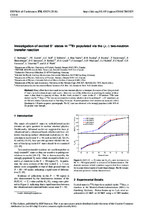| dc.contributor.author | Burbadge, C. | |
| dc.contributor.author | Triambak, S. | |
| dc.contributor.author | Wirth, H.-F. | |
| dc.date.accessioned | 2019-10-07T12:21:52Z | |
| dc.date.available | 2019-10-07T12:21:52Z | |
| dc.date.issued | 2018 | |
| dc.identifier.citation | Investigation of excited 0+ states in 160Er populated via the (p, t) two-neutron transfer reaction C. Burbadge, P.E. Garrett, G.C. Ball, V. Bildstein, A. Diaz Varela, M.R. Dunlop, R. Dunlop, T. Faesternann, R. Hertenberger, D.S. Jamieson, D. Kisliuk, K.G. Leach, J. Loranger, A.D. MacLean, A.J. Radich, E.T. Rand, C.E. Svensson, S. Triambak and H.-F. Wirth EPJ Web Conf., 178 (2018) 02025 DOI: https://doi.org/10.1051/epjconf/201817802025 | en_US |
| dc.identifier.issn | 2100-014X | |
| dc.identifier.uri | https://doi.org/10.1051/epjconf/201817802025 | |
| dc.identifier.uri | http://hdl.handle.net/10566/5009 | |
| dc.description.abstract | Many efforts have been made in nuclear structure physics to interpret the nature of low-lying excited 0+ states in well-deformed rare-earth nuclei. However, one of the difficulties in resolving the nature of these states is that there is a paucity of data. In this work, excited 0+ states in the N = 92 nucleus 160Er were studied via the 162Er(p, t)160Er two-neutron transfer reaction, which is ideal for probing 0+ → 0+ transitions, at the Maier-Leibnitz-Laboratorium in Garching, Germany. Reaction products were momentum-analyzed with a Quadrupole-3-Dipole magnetic spectrograph. The 0+2 state was observed to be strongly populated with 18% of the ground state strength. | en_US |
| dc.language.iso | en | en_US |
| dc.publisher | EDP Sciences | en_US |
| dc.subject | Nuclear structure physics | en_US |
| dc.subject | Rare-earth nuclei | en_US |
| dc.subject | Excited 0+ states | en_US |
| dc.subject | Two-neutron transfer reaction | en_US |
| dc.title | Investigation of excited 0+ states in 160Er populated via the (p, t) two-neutron transfer reaction | en_US |
| dc.type | Article | en_US |

